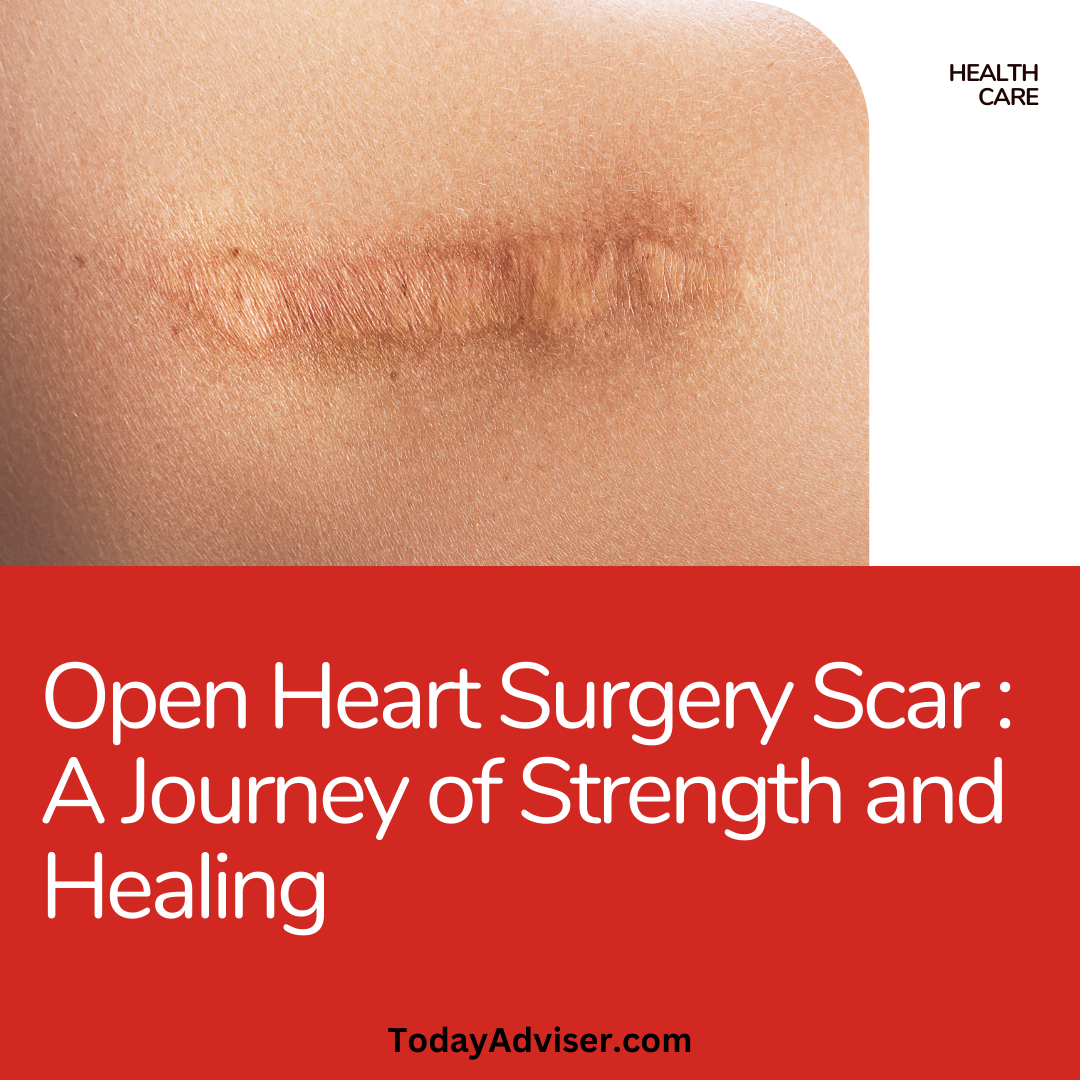
An open heart surgery scar is a visible mark on the skin resulting from the surgical procedure. Open heart surgery scar is a prominent reminder of a major surgical procedure that involves opening the chest to access and repair the heart.
This scar is a permanent reminder for patients who have undergone the surgery, and it can vary in size, shape, and appearance depending on the surgical technique used. While the scar may initially be red and raised, it typically fades and flattens over time, becoming less noticeable.
Despite being a physical reminder of a challenging experience, many individuals view their open heart surgery scar as a symbol of strength and resilience. Understanding the development and care of these scars can help patients and their loved ones navigate the healing process with confidence and optimism.

The Impact Of Open Heart Surgery On Scars
The Impact of Open Heart Surgery on Scars
Open heart surgery is a life-saving procedure that often leaves a lasting mark – a scar. This scar is not only a physical reminder of the battle fought inside the operating room, but it can also have a significant impact on the individual’s emotional and psychological well-being. It is important to understand the factors that influence the appearance of scars after open heart surgery and the healing process they undergo.
Factors Influencing The Appearance Of Scars After Open Heart Surgery
Several factors determine how a scar will look and feel after open heart surgery. These factors include:
- The type of incision: The location and size of the incision play a crucial role in scar formation. Surgeons carefully choose the placement of the incision to minimize its visibility, taking into account factors such as the patient’s anatomy and the nature of the surgery.
- Individual healing ability: Each person’s body is unique, and their ability to heal varies. Some individuals are genetically predisposed to develop more prominent scars, while others may have a faster healing process, leading to less noticeable scars.
- Infection and complications: Infections or other post-surgical complications can disrupt the normal healing process, potentially resulting in more pronounced scars.
- Suture technique: The technique used to close the incision, such as the type of sutures and how they are layered, can impact scar formation. Surgeons employ various suturing techniques to minimize tension and ensure proper wound closure, which can contribute to a more favorable scar appearance.
The Healing Process Of Open Heart Surgery Scars
The healing process of open heart surgery scars is a complex and fascinating journey. After the incision is closed, the body initiates a series of events to repair the damaged tissue and form scar tissue. Here is a general outline of the healing stages:
- Inflammatory stage: The body triggers an inflammatory response to remove debris and begin repairing damaged tissue. During this stage, the scar may appear red, swollen, and tender.
- Proliferative stage: New blood vessels form, and collagen production increases, helping to rebuild the damaged tissue. The scar may start to itch and become firmer during this stage.
- Remodeling stage: Over time, the scar tissue continues to mature and undergo remodeling, improving its appearance. The scar may fade and become less noticeable, although it is unlikely to disappear completely.
It is essential to note that everyone’s healing process is unique, and scars may heal at different rates. Proper wound care, such as keeping the incision clean and moisturized, protecting it from excessive sun exposure, and following the surgeon’s post-operative instructions, can support the healing process and help minimize the scar’s visibility.

Embracing And Accepting Open Heart Surgery Scars
Receiving open heart surgery is a remarkable feat of strength and resilience. It is a life-changing experience that not only transforms your health but also leaves behind physical scars as a reminder of the journey you have embarked upon. While these scars may initially seem daunting or even distressing, it is essential to embrace and accept them as a part of your new self. In this article, we will explore how to come to terms with the physical changes after open heart surgery and how to cultivate self-acceptance and self-confidence, ultimately empowering yourself to embrace and love the open heart surgery scars.
Cultivating Self-acceptance And Self-confidence
Open heart surgery scars are a testimony to the incredible strength and endurance your body possesses. Instead of viewing them as flaws, you can choose to see them as badges of honor, representing the battle you fought and conquered. Embracing your scars starts with cultivating self-acceptance and self-confidence. Here are some ways to achieve this:
- Practice self-care: Treat yourself with care and kindness. Prioritize your physical and emotional well-being by following a balanced diet, engaging in regular exercise, and practicing mindfulness or meditation.
- Surround yourself with a supportive community: Share your journey with loved ones or join support groups and online communities for individuals who have undergone open heart surgery. Connecting with others who have similar experiences can help you feel understood and accepted.
- Focus on your accomplishments: Remember all the achievements you have attained, both before and after your surgery. Acknowledge the strength and resilience you possess, celebrating the milestones you have reached.
- Embrace your uniqueness: Your scars make you unique, showcasing the battles you have conquered. Embrace these differences and learn to love and accept yourself as a whole.
Coming To Terms With The Physical Changes After Open Heart Surgery
Coming to terms with the physical changes after open heart surgery can be a gradual process. It is crucial to remember that your scars do not define you; they are only a small part of your larger self. Below are some strategies to help you navigate and accept these changes:
- Education and understanding: Learning about the process of open heart surgery, including information about scarring and the body’s natural healing process, can help demystify and normalize the changes you see.
- Self-exploration and empowerment: Take the time to explore and connect with your body. Examine your scars, observe their uniqueness, and see them as symbols of strength and survival.
- Positive affirmations: Replace negative self-talk with positive affirmations. Remind yourself of your resilience and courage, and reinforce the belief that your scars are a testament to your ability to overcome challenges.
- Style and fashion choices: Experiment with different clothing styles and accessories that make you feel confident and comfortable. Find creative ways to showcase your scars or choose outfits that draw attention away from them if that is your preference.
Remember, embracing and accepting open heart surgery scars is a personal journey. It takes time, patience, and self-love, but by cultivating self-acceptance and adopting strategies for embracing the physical changes, you can embark on a path of healing and self-discovery.
Coping Strategies For Emotional Healing
Recovering from open heart surgery goes beyond physical healing. It also involves addressing the emotional impact of the surgery, particularly the presence of a noticeable scar. Dealing with feelings of insecurity and anxiety and seeking support from loved ones and support groups are essential coping strategies for emotional healing post-surgery. Let’s take a closer look at these strategies.
Dealing With Feelings Of Insecurity And Anxiety
Having an open heart surgery scar can sometimes lead to feelings of insecurity and anxiety. It’s important to acknowledge and address these emotions in order to foster emotional healing. Here are some strategies to deal with these feelings:
- Practice self-acceptance: Accept that your scar is a visible reminder of your journey towards better health. Embrace it as a symbol of resilience and strength.
- Positive self-talk: Remind yourself of your courage and the steps you took to improve your health. Engage in positive self-talk to counter any negative thoughts or insecurities.
- Focus on the positive: Instead of dwelling on the scar, focus on the progress you have made in your recovery. Celebrate your accomplishments and the fact that you are now on a healthier path.
- Engage in self-care: Take care of yourself both physically and emotionally. Engaging in activities that bring you joy and practicing self-care can help boost your self-confidence and reduce anxiety.
Seeking Support From Loved Ones And Support Groups
When coping with the emotional impact of an open heart surgery scar, support from loved ones and support groups can make a significant difference. Here’s how you can seek support:
- Talk openly: Share your feelings and concerns with your loved ones. Their understanding and support can provide you with comfort and reassurance.
- Join a support group: Consider joining a support group specifically for individuals who have undergone open heart surgery. Connecting with others who have had similar experiences can be uplifting and provide a sense of belonging.
- Attend therapy: Individual therapy can be beneficial in navigating the emotional challenges that arise from having a visible scar. A therapist can provide guidance and tools to help you cope with any insecurities or anxieties.
- Explore online communities: There are online communities and forums where individuals share their experiences and offer support to one another. Engaging with these communities can help you feel less alone and provide valuable insights.
By implementing these coping strategies, you can work towards emotional healing and develop a positive mindset towards your open heart surgery scar. Remember, you are not defined by your scar but by the strength and resilience it represents.
Scar Care And Healing Tips
Proper wound care plays a crucial role in promoting faster healing of an open heart surgery scar. Taking care of your scar is essential to ensure optimal healing and reduce the visibility of the scar over time. In this article, we will explore some practical tips and recommended scar treatments and products to help you take care of your open heart surgery scar. Follow these guidelines to promote better healing and achieve an improved appearance of your scar.
Proper Wound Care To Promote Faster Healing
Appropriate wound care is essential after an open heart surgery to facilitate faster healing. Follow these steps to ensure your scar heals well:
- Keep the wound clean and dry: Clean the incision site with mild soap and water, carefully pat it dry, and avoid using harsh chemicals or abrasive materials.
- Protect the scar from infection: Apply an over-the-counter antibiotic ointment and cover the incision site with a sterile dressing to prevent bacteria from entering.
- Avoid excessive movement and strain: Minimize movements that can put strain on the incision site, as it may disrupt the healing process. Follow any movement restrictions provided by your healthcare provider.
- Practice good nutrition: Proper nutrition is essential for optimal wound healing. Ensure your diet includes a variety of vitamins and minerals, especially vitamin C, protein, and zinc, which aid in the healing process.
- Manage pain and discomfort: Follow your healthcare provider’s instructions for pain management, as pain can significantly affect your ability to take care of your scar.
Recommended Scar Treatments And Products
While scars are a natural part of the healing process, certain treatments and products can help improve their appearance. Consider the following options:
| Treatment/Product | Description |
|---|---|
| Silicone gel or sheets | A popular scar treatment that helps to soften and flatten scars, reducing their appearance over time. |
| Topical creams and ointments | Scar creams and ointments containing ingredients like vitamin E, aloe vera, and cocoa butter can help moisturize the scar and improve its overall appearance. |
| Steroid injections | In some cases, steroid injections may be recommended by your healthcare provider to reduce the size and redness of the scar. |
| Laser therapy | Laser treatments can be effective in reducing the appearance of scars by promoting collagen production and breaking down scar tissue. |
Consult with your healthcare provider to determine the most suitable scar treatment for your specific situation. Keep in mind that each scar is unique, and what works for one person may not have the same results for another.
Reclaiming Strength And Empowering Others
Open heart surgery leaves behind a powerful symbol of resilience and strength – the scar. While some may see it as a mark of vulnerability, it can also serve as a badge of courage, reminding us of the battles we have fought and overcome. In reclaiming our strength, we not only empower ourselves but also become an inspiration to others. By sharing personal stories of resilience and courage, we encourage individuals to embrace their scars and find strength in vulnerability.
Sharing Personal Stories Of Resilience And Courage
Personal stories have the unique power to connect people on a deeper level. When we share our experiences of overcoming challenges and showcasing resilience, we create a sense of belonging and support for those who may be on a similar journey. These stories not only shed light on the physical and emotional struggles but also demonstrate the incredible strength and determination that lies within each individual.
In sharing personal stories, individuals who have undergone open heart surgery can inspire and encourage others facing their own battles. By highlighting the process of recovery, the obstacles faced, and the triumph in coming out stronger, these stories become beacons of hope and motivation. They remind us that the human spirit is capable of incredible resilience and that we are not alone in our struggles.
Inspiring Others To Embrace Their Scars And Find Strength In Vulnerability
Embracing our scars is an act of self-acceptance and self-love. It is a powerful statement that says we are more than the physical marks we bear – we are survivors. Open heart surgery scars serve as a reminder of the resilience of the human body and the indomitable spirit within us. By embracing our scars, we transform them from perceived imperfections into symbols of strength and triumph.
By encouraging others to embrace their scars as well, we create a community of support and empowerment. We enable individuals to see beyond their physical appearance and recognize the inner strength that lies within. Scars become testaments to the battles we have fought and the victories we have achieved. They become reminders that vulnerability does not equate to weakness, but rather to courage.
Through our collective embrace of scars, we redefine societal beauty standards and dismantle the notion that perfection lies in flawlessness. We celebrate ourselves and each other for our resilience, recognizing the beauty that lies in authenticity and vulnerability. Together, we inspire and uplift one another, forging a path towards self-empowerment and acceptance.
Frequently Asked Questions For Open Heart Surgery Scar
How Long Does It Take For An Open Heart Surgery Scar To Heal?
The healing time for an open heart surgery scar can vary from person to person. Generally, it takes around 6 to 12 weeks for the scar to heal completely. However, it may take up to a year for the scar to fade and become less noticeable.
What Can I Do To Minimize The Appearance Of My Open Heart Surgery Scar?
To minimize the appearance of an open heart surgery scar, you can follow these tips:
– Keep the incision site clean and dry
– Apply silicone gel or sheets to the scar
– Massage the scar gently
– Protect the scar from sun exposure
– Consult with a dermatologist or plastic surgeon for additional treatments such as laser therapy or scar revision surgery.
Will My Open Heart Surgery Scar Ever Go Away?
While an open heart surgery scar may never completely go away, it can fade over time and become less noticeable. Taking proper care of the scar, following skincare routines, and considering additional treatments can help in reducing the visibility of the scar.
However, it’s important to remember that every person’s healing process is unique.
Conclusion
The open heart surgery scar is a visible reminder of the strength and resilience of the human body. While it may initially cause concern or self-consciousness, it is important to embrace and celebrate the bravery and journey it represents. With proper care and time, the scar can fade and become a symbol of survival and triumph.
By understanding and normalizing the open heart surgery scar, we can foster a culture of acceptance and appreciation for the remarkable healing process of the human body. Embrace your scar, for it tells a story of courage and triumph.



